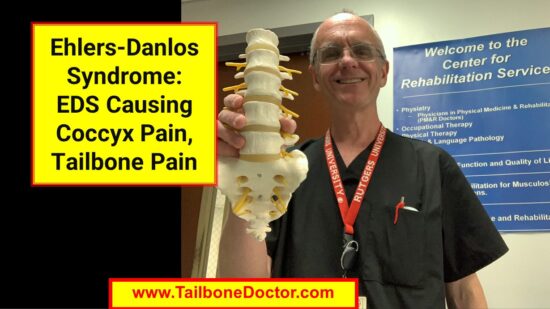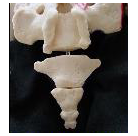Here is the transcript from the video on Ehlers Danlos Syndrome and tailbone pain. The actual Video is at the bottom of this article.
Let’s talk briefly about EDS (or Ehlers-Danlos Syndrome) and EDS as a cause of coccyx pain or tailbone pain or coccydynia.
I’m Dr. Patrick Foye. I’m an M.D. (or medical doctor) and Director of the Coccyx Pain Center here in the United States, online at www.TailboneDoctor.com.
EDS is a condition where it’s a connective tissue disorder.
And it results in increased joint laxity, meaning looseness of the joints… that the joints are not as stiff or well supported as they normally should be.
And that causes increased mobility or movement of the joints.
Now, the joints then can become unstable or hyper-mobile, meaning that they move too much.
Now, coccyx pain is a condition down at the bottom of the spine.
So, here’s an anatomic model of the spine showing the lumbar spine and then the sacrum and then down at the lowest tip of the spine is the coccyx or tailbone.
And the tailbone is supposed to have a little bit of movement but not too much.
And the most common cause of tailbone pain or coccyx pain overall is patients that have hyper-mobility.
The ligaments of the coccyx are relatively thin. They’re not very strong. And they can become loose over time or as a result of trauma.
And that can happen in all of us, even people without EDS.
So, the number one cause of coccyx pain overall in patients is hyper mobility… that there’s dynamic instability (there’s excessive movement at the tailbone)… that when you go to sit and if you and your tailbone is supposed to flex forward just a little… but it flexes forward too much and there’s excessive movement and pain associated with that.
So, given that, overall, hypermobility is the number one cause of coccyx pain… and given that EDS causes hypermobility of joints in general… it’s no surprise that people with EDS may run into problems with hypermobility at the tailbone.
The way to diagnose that is by doing sitting-versus-standing x-rays.
That way the x-rays can be done while you’re standing but also while you’re sitting and putting your body weight onto the tailbone… so sitting leaning part way back the x-rays can be done in that position as well.
And we can compare the position and the angle of the coccyx while you’re sitting compared with while you’re standing.
And that’s the way we diagnose hypermobility at the coccyx.
The problem though is that many radiology centers have never heard of doing the sitting-versus-standing coccyx x-rays or they don’t have experience or expertise in doing them.
So, admittedly, that is one potential challenge.
But that’s a little bit of information about EDS and coccyx pain or coccydynia and hypermobility and sit-stand x-rays.
Hopefully you found that helpful.
If you are interested in more information about tailbone pain, certainly you can find my book on Amazon, which is called “Tailbone Pain Relief Now!”
And if you’re interested in more information you can also go to my website www.TailboneDoctor.com.
And you can if you’re interested in seeing me in-person you can also go to the www.TailboneDoctor.com website and there’ll be information on that there.
So, okay, all the best. Bye.
Here is the VIDEO: https://youtu.be/G855L4OjXRc
Here is the screenshot from the video:

Here is another article by Dr. Foye on the topic of Ehlers Danlos Syndrome and tailbone pain: https://tailbonedoctor.com/eds-ehlers-danlos-syndrome-and-tailbone-pain/
COME FOR RELIEF: For more information on coccyx pain, or to be evaluated in-person by Dr. Foye’s Coccyx Pain Center in the United States, go to: www.TailboneDoctor.com
– Patrick Foye, M.D., Director of the Tailbone Pain Center, New Jersey, United States.
- Coccygectomy: Expected Recovery and Return to Work after surgery for coccyx pain, tailbone pain. - November 28, 2023
- PRP Platelet Rich Plasma or Prolotherapy for Tailbone Pain, Coccyx Pain - October 25, 2023
- Reasons for Normal X-rays and MRI Despite Tailbone Pain, Coccyx Pain - October 3, 2023

